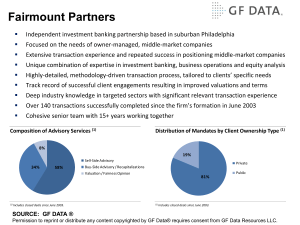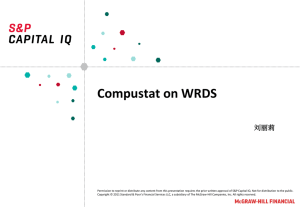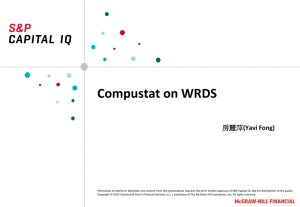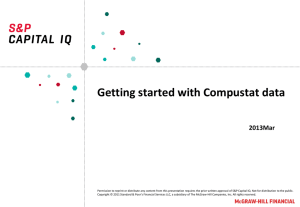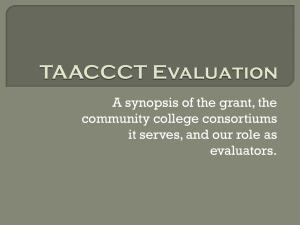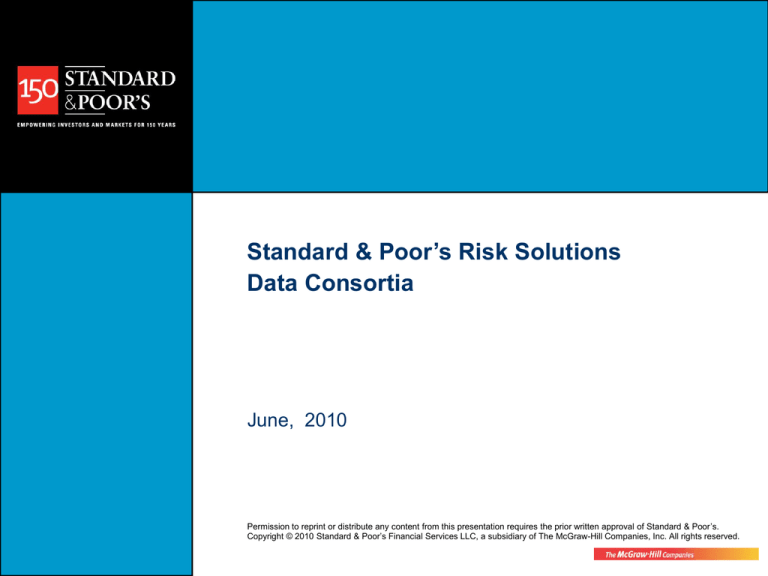
Standard & Poor’s Risk Solutions
Data Consortia
June, 2010
Permission to reprint or distribute any content from this presentation requires the prior written approval of Standard & Poor’s.
Copyright © 2010 Standard & Poor’s Financial Services LLC, a subsidiary of The McGraw-Hill Companies, Inc. All rights reserved.
Agenda
• Standard & Poor’s Risk Solutions – Introduction
• Data Consortium – What is it?
• Why are Consortia Needed?
• Benefits of a Credit Data Consortium
• What does Standard & Poor’s Provide?
– Step 1: Initial diagnosis
– Step 2: Implementation of the consortium
– Step 3: PD data pooling, cleaning, aggregating, testing and analysis of the data
– Step 4: Reporting & Deliverables
– Step 5: Building models on the aggregated data
• Standard & Poor’s Consortia Experience
Permission to reprint or distribute any content from this presentation requires the prior written approval of Standard & Poor’s.
2.
Standard & Poor’s Risk Solutions - Introduction
Permission to reprint or distribute any content from this presentation requires the prior written approval of Standard & Poor’s.
3.
Standard & Poor’s Risk Solutions - Introduction
• Standard & Poor's Risk Solutions provides financial analysis and risk
management solutions to assist credit sensitive institutions make
informed decisions regarding originating, measuring and managing
credit risk arising from their day-to-day business activities
• We address all major components of financial analysis, including data,
methodologies and processes for the analysis of probability of default,
loss given default and exposure at default
• These integrated credit risk management solutions leverage Standard &
Poor's experience in credit assessment to help institutions manage
credit risk, calculate economic and regulatory capital, and manage their
balance sheets more effectively
Permission to reprint or distribute any content from this presentation requires the prior written approval of Standard & Poor’s.
4.
Standard & Poor’s Risk Solutions - Introduction
• Core Competencies
– Internal Rating Systems
Internal rating systems design, assessment and improvement
Obligor and facility ratings
Validation
– Models. Off-the-shelf and custom models to measure PD, LGD or
to estimate credit ratings
– Data. Globally we facilitate or run a significant number of data
collection exercises
– PD & LGD. PD & LGD data collection, analysis and modeling. S&P
Risk Solutions is a leader in this field
Permission to reprint or distribute any content from this presentation requires the prior written approval of Standard & Poor’s.
5.
S&P Risk Solutions – corporate structure
• Confidential information is “firewalled” between Risk Solutions and the
Rating Services of Standard & Poor’s. Risk Solutions is a “nonratings” business of Standard & Poor’s
Standard & Poor's
Fixed Income & Risk
Management Services
Leveraged
Commentary
& Data
Risk
Solutions
Rating Services
Structured
Finance
Ratings
Permission to reprint or distribute any content from this presentation requires the prior written approval of Standard & Poor’s.
6.
Corp. &
Govt.
Ratings
Data Consortium – What is it?
Permission to reprint or distribute any content from this presentation requires the prior written approval of Standard & Poor’s.
7.
Data Consortium – What is it?
• A Data Consortium is a group of banks that agree to pool data, usually
on a confidential basis, to a central repository, whereupon data
cleansing, aggregation and analysis takes place
• The data will typically relate to one or more homogeneous asset class
and may be examining default or both default and recovery, or just
recovery
• Standard & Poor’s preserves the confidentiality of both the bank’s
clients and the performance of the individual bank’s portfolio
• Reporting outputs by Standard & Poor’s are agreed collectively with the
participating banks
• Standard & Poor’s could develop PD & LGD Models from the
aggregated data
Permission to reprint or distribute any content from this presentation requires the prior written approval of Standard & Poor’s.
8.
Why are Consortia needed?
Permission to reprint or distribute any content from this presentation requires the prior written approval of Standard & Poor’s.
9.
Why are Consortia needed?
• Individual banks’ default and loss experience is relatively sparse
within specific asset, industry and collateral sub-groups
– often relatively few defaults a year
– resolution of final losses can take considerable time
– scarcity drives compromise; one must balance statistical significance
against granularity of estimates produced
• Need bigger, deeper data set to provide more statistically robust
information quicker
– to achieve objective of estimating PD and LGD as accurately as possible
– difficult for banks to address individually
– it may be that the whole market does not have statistically robust data
for certain asset classes, but this should be demonstrated
Permission to reprint or distribute any content from this presentation requires the prior written approval of Standard & Poor’s.
10.
Why are Consortia needed?
• Importance of robust Probability of Default (PD) and Loss Given
Default (LGD) benchmarks
– Pressure for change in approach to credit risk measurement
Risk based pricing and economic capital allocation require the separate
consideration of PD & LGD
Basel II Internal Ratings Based Approaches (Foundation and Advanced)
– Both are important in determining expected loss and unexpected
loss
For level of capital – capital is a buffer against uncertain outcome
For capital allocation – risk-based pricing & performance management
For credit risk management processes
Multi-dimensional ratings
Permission to reprint or distribute any content from this presentation requires the prior written approval of Standard & Poor’s.
11.
PD and LGD meeting banking needs
Business
Development
Loan
Origination
Credit
Approval
Portfolio
Management
• Database on
clients and
prospects
• Benchmark
comparison
• Model
• Pro forma
pricing
• Loan/Credit
MIS (Mgt info
System)
• Stress Test
• Formal
assessment
of pricing
• Financial
Statement
Spreading
• Stress Test
(Company
and industry)
• Pricing
assessment
• Is credit rated
properly?
• Stress Test
• Portfolio
analysis
• Risk
Mitigation
• Expected loss
Permission to reprint or distribute any content from this presentation requires the prior written approval of Standard & Poor’s.
12.
Treasury/
CFO/CEO
• Economic
Capital
• Securitisation
• Regulatory
Capital
management
• RAROC
• Unexpected
loss
Benefits of a Credit Data Consortium
Permission to reprint or distribute any content from this presentation requires the prior written approval of Standard & Poor’s.
13.
Benefits of a Credit Data Consortium
• With Basel II, Banks have to move away from the traditional
assessment of lending on an “Expected Loss” basis and separate it
into the probability of default (PD) and the loss given default (LGD). The
data collected in pooling exercises greatly facilitates this exercise, both
by providing more robust statistics and, in certain instances, by
enabling the construction of quantitative models
• All banks will benefit by the more rapid aggregation of data and the
building of a robust set of normalized statistics. In fairly short order the
banks will receive their own conformed default experience compared
with the industry as a whole, together with some key financial
statement benchmarks
• Stakeholders
– Banks (large & small)
– Regulator
– Data Agent & Supplier of Services
Permission to reprint or distribute any content from this presentation requires the prior written approval of Standard & Poor’s.
14.
Benefits of a Credit Data Consortium
•
For the larger banks:
–
Those aspiring to Advanced IRB status can build up more observations on
recovery more quickly. LGD has to be captured over a period of time, often
considerable, whereas default is a binomial, instantaneous event
–
The consortium can decide to exchange data with a consortium in another
country, which would prove useful should the bank be in that market or
considering entry
–
Although a bank may be large, smaller banks often have interesting
regional or industry-specific data, so that their data, whilst not so
numerous, may still add value to the larger bank
–
Large banks, when using the benchmark data to present comparative
analysis to external parties, such as regulators or rating agencies, can
refute suggestions of “cherry picking” if they include all the banks
–
The banks receive expert advice on how to compile an appropriate
database of its own credit experience
Permission to reprint or distribute any content from this presentation requires the prior written approval of Standard & Poor’s.
15.
Benefits of a Credit Data Consortium
•
For the smaller banks:
– Access to countrywide experience
– A benchmarking portfolio that replicates the market
– Insight on the experience in particular industrial sectors, in which
it is not presently participating, thus informing expansion
decisions
– Some of the “large” bank benefits apply – for instance, a “small”
bank in the corporate market may be a large retail lender that
would benefit from attaining the Advanced IRB standard
Permission to reprint or distribute any content from this presentation requires the prior written approval of Standard & Poor’s.
16.
Benefits of a Credit Data Consortium
•
For the larger and smaller banks:
– Top management has benchmarks against which to assess the
performance of their own bank
– The business development area has benchmark comparisons on
lending decisions and pricing
– Credit Risk departments can benchmark their internal credit
ratings
– Guidance for stress-testing and scenario analysis
– An informed strategy and risk appetite, from industry and regional
analysis
– More accurate pricing and analytical assumptions for CDOs.
– The underpinning by facts of assumptions for RAROC models
Permission to reprint or distribute any content from this presentation requires the prior written approval of Standard & Poor’s.
17.
Benefits of a Credit Data Consortium
•
For the Regulator:
– A reliable historical benchmark against which the performance of
each bank can be measured using conformed data. Interpretation
of the results is still essential – a higher default rate may be
indicative of a greater risk appetite in that bank and supported by
higher margins
– The bigger, deeper data set should lead to an improvement in the
quality of risk management throughout the industry
– Successful implementation of the consortium would cement a
reputation as a forward-looking regulator. For instance, Saudi
Arabia has led the way and other regulators are contemplating
consortia
Permission to reprint or distribute any content from this presentation requires the prior written approval of Standard & Poor’s.
18.
Benefits of a Credit Data Consortium
•
Benefits of (i.e. data driven) quantitative Models:
– A robust benchmark for a bank’s own IRB internal rating system
Or, an input to a bank’s own IRB with the bank’s expert judgment overlay
– Leverage of S&P’s expertise, with the overhead effectively spread
over the members of the consortium
– An effective tool for the analysis of structured transactions
– A quick and effective input to pricing and economic capital
allocation models
– A tool for rapid assessment of potential new business, marketing
approaches, etc.
Permission to reprint or distribute any content from this presentation requires the prior written approval of Standard & Poor’s.
19.
Data Ownership
• Ownership of the data remains with the banks throughout
• We are highly experienced in maintaining the confidentiality of
information – it is core to many facets of our business
• All distribution of conformed statistics back to banks does not
reference individual customers and is sufficiently aggregated to
disguise the portfolio of individual banks
• We could build models trained on the aggregated data, but it
does not distribute the data in any manner
– Numerical identifiers can be substituted
Permission to reprint or distribute any content from this presentation requires the prior written approval of Standard & Poor’s.
20.
What does Standard & Poor’s Provide?
Permission to reprint or distribute any content from this presentation requires the prior written approval of Standard & Poor’s.
21.
What does Standard & Poor’s provide?
• Step 1: Initial Diagnosis of potential data availability
– Detailed Structured Questionnaire
– Management Interviews
– Security Requirements
– Questions & Answers for consortium members
• Step 2: Implementation of the Consortium
– Agreement on the consortia structure and terms of reference
– Agreement on the deliverables
• Step 3: Pooling, cleaning, aggregating, testing and validation of the data
• Step 4: Delivering the data reports
• Step 5: Building models on the aggregated data
Permission to reprint or distribute any content from this presentation requires the prior written approval of Standard & Poor’s.
22.
What does Standard & Poor’s provide?
Step 1: Initial diagnosis of potential data availability
Permission to reprint or distribute any content from this presentation requires the prior written approval of Standard & Poor’s.
23.
What does Standard & Poor’s provide?
• Step 1: Initial diagnosis of potential data availability
– For each Member Bank review the existing data and workflows and
so determine:
Definitions and standards of default, emergence, and recovery
Volume and historical timeframe of existing datasets
Format and structure of non-electronic documentation
Data storage format – in databases, desktop PC’s, paper files
Data storage location geographically
Early view of portfolio (to help develop segmentation)
Workflows for existing loans, distressed and defaulting credits
Structure of datasets versus an “ideal” dataset
The IT environment of the bank
– Leading to an efficient and effective implementation of the
consortium
Permission to reprint or distribute any content from this presentation requires the prior written approval of Standard & Poor’s.
24.
What does Standard & Poor’s provide?
Step 2: Implementation of the consortium
Permission to reprint or distribute any content from this presentation requires the prior written approval of Standard & Poor’s.
25.
What does Standard & Poor’s provide? - Governance
• Step 2: Implementation of the consortium
– It is important to establish the “rules of the game” at the outset
– There are a number of feasible structures
– We favour an appropriately resourced two-committee structure
A Management Committee to take policy decisions, inevitably all events
cannot be predicted at the outset
A Methodological Committee dealing with technical issues in more detail
– Standard & Poor’s can assist in drawing up Terms of Reference for
the Committees
Permission to reprint or distribute any content from this presentation requires the prior written approval of Standard & Poor’s.
26.
What does Standard & Poor’s provide? - Consortium Organization
Management
Committee
S&P
Permission to reprint or distribute any content from this presentation requires the prior written approval of Standard & Poor’s.
27.
Methodology
Committee
S&P
What does Standard & Poor’s provide? - Consortium Organization
• Management Committee decisions
– acceptance of new members
– communicating with banks not in compliance
– sharing some statistics with other consortia
• Methodology Committee
– minimum standards (“must have” data fields & quantity)
– model drivers discussion with Standard & Poor’s experts
– Standard & Poor’s contributes knowledge and experience
Permission to reprint or distribute any content from this presentation requires the prior written approval of Standard & Poor’s.
28.
Probability of Default (PD) Data Consortium Basics
• For each bank in the consortium S&P links the history of Borrower’s
Credit performance and Other Borrower Data (qualitative) to the history
of that borrower’s financial performance
• The aggregate set allows predictive modeling of credit performance
based on time series of financial accounts
• Approach effective for middle-market and corporates where financial
performance determines credit performance and a statistically large
number of cases can be collected
Borrower
Credit Performance
Histories and Other
Borrower Information
Borrower
Financial Performance
Histories
Link
Industry
Geography
Company Type
Asset Class
Instrument Payment
Delinquencies
Write-offs
Financial Statement
Accounts
Permission to reprint or distribute any content from this presentation requires the prior written approval of Standard & Poor’s.
29.
What does Standard & Poor’s provide?
Step 3: PD data pooling, cleaning, aggregating,
testing and analysis of the data
Permission to reprint or distribute any content from this presentation requires the prior written approval of Standard & Poor’s.
30.
What does Standard & Poor’s provide?
• Step 3: PD data pooling, cleaning, aggregating, testing and
analysis of the data
– Objective - aggregate a robust PD dataset for quantitative modeling and
statistical benchmarking
– Collect a sufficient number of observations (both defaulters and performing
companies)
– Best practices PD data set – combination of borrowers’ credit histories and
their financial histories
– Rely on objective data elements (financials, balances, days past due, etc.)
– Aggregate a chronologically “deep” data set - covering one economic cycle
– Quality of data: ensure that all aspects of consortium data are a close
representation of the credit reality in the marketplace
Permission to reprint or distribute any content from this presentation requires the prior written approval of Standard & Poor’s.
31.
Middle Market PD Data for Model Development – Data Quantity
• Corporate/SME modelling
• To develop a powerful model, a data set of 400 to a500 defaulted
entities (entire consortium)
• Most effective way to achieve consortium goals – historical PD data
submission (3-4 years) + data going forward, and LGD collection (a ”goforward approach”)
Borrower Count
Cumulativ e Distribution for Pe rforming and
De faulte d Borrowe rs
4,000
3,500
3,000
2,500
2,000
1,500
1,000
500
0
Performing
Defaults
1
2
3
4
5
6
7
Year
Permission to reprint or distribute any content from this presentation requires the prior written approval of Standard & Poor’s.
32.
8
PD Data Process Flow
Mapping
Data
Validation
Routines
Matching,
Linking Extracts,
Treating
Duplicates, i.e.
Data
Standardization
Develop a “System”
Permission to reprint or distribute any content from this presentation requires the prior written approval of Standard & Poor’s.
33.
Data Consolidation
Reporting
PD Data Structure
Loan Accounting
System
Borrower 1
Statement FYE 1
Statement FYE 2
Statement FYE 3
Financial Statements
from Spreading System
Borrower 1
Borrower 2
Borrower 3
Borrower 2
Statement FYE 1
Statement FYE 2
Statement FYE 3
Portfolio Default Report
Industry
Geography
Company Type
Asset Class
Instrument Payment
Delinquencies
Borrower 3
Statement FYE 1
Statement FYE 2
Statement FYE 3
Balance Sheet Items
Income Statement Items
Statement Period (Year)
Audit Quality
Permission to reprint or distribute any content from this presentation requires the prior written approval of Standard & Poor’s.
34.
Counts of Defaulters
vs. all companies
in portfolio
Bank’s Historical Financial Statements - Scenario 1
Borrower
Financial
Statements
Bank-analysts
have already
input over the years
Statements
already in database format
Database
Many 1000s of Statements
Project Action: Data is
extracted for matching
and clean-up
Name Matching
Statements Table
(“unrefined” data)
Permission to reprint or distribute any content from this presentation requires the prior written approval of Standard & Poor’s.
35.
Loan
Accounting
System
Bank’s Historical Financial Statements - Scenario 2
Borrower
Financial
Statements
Bank-analysts
have already
input over the years
Extracts containing
multiple electronic
borrower files
Data Aggregation
Project Action: Data is
extracted from many
hard-drives and aggregated
Name Matching
Statements Table
(“unrefined” data)
Permission to reprint or distribute any content from this presentation requires the prior written approval of Standard & Poor’s.
36.
Loan
Accounting
System
Data Clean-up Tools Example
Name-matching
Permission to reprint or distribute any content from this presentation requires the prior written approval of Standard & Poor’s.
37.
Data Standardization – Chart of Accounts Mapping
Bank-specific Chart of Accounts
Total Assets
Total Assets
Trade
Receivabes
Accounts
Receivable
Subsidiary
Receivables
Other
Receivables
Turnover
Consulting
Income
Revenues
Standard Chart of Accounts
Permission to reprint or distribute any content from this presentation requires the prior written approval of Standard & Poor’s.
38.
Total Net
Worth
Total Equity
Proposed Data Validation Process
Data Quality Assessment
Stage 2
Borrower Matching
And Removal
Of Duplicates
Data Quality Assessment
Stage 3
Portfolio Level
Data Analysis
Methodology Committee
Provides Guidance
Data Quality Assessment
Stage 1
Automated Data
Integrity Checks
Management Committee
Provides Feedback
And Directs Action
Data Quality
Workshops
Are Held At the
Beginning Of Every
New Collection Cycle
Permission to reprint or distribute any content from this presentation requires the prior written approval of Standard & Poor’s.
39.
Management
Committee
Data Quality
Report and Review
Data Validation Process – Automated Data Checks
Rule
No.
Data
Secti
on
Data Table
Rule Name
Rule Ensures
Financial statement date must be provided.
11
PD
FSData
FS Date check
(blank)
17
PD
FSData
Audit Qual
check (blank)
Audit Quality must be provided.
19
PD
FSData
Curr check
Currency must be provided.
State or Province Code is provided.
5
PD
FSCompany
State/Province
Code check
6
PD
FSCompany
Country Code
check
Country Code is not null or invalid.
76
LGD
LASBorrower
Pub/Priv check
Public/Private Indicator must be provided.
77
LGD
LASBorrower
78
LGD
LASData
79
LGD
LASData
Hold/Oper
check
Loan ID.01
check
Loan ID.02
check
LGDBorrower
Borrower
Linking Check
BorrowerID must be the same and exist in all tables
Collateral ID must link to a LoanID or BorrowerID
13
LGD
Holding/Operating Indicator must be provided.
Loan ID or Facility ID must be provided.
Loan ID or Facility ID must be unique for each loan/facility.
14
LGD
LGDCollateral
Collateral
Linking Check
91
LGD
LASData
Orig Dt.05
check
Origination Date < Default Date
Origination Date < Resolution Date
92
LGD
LASData
Orig Dt.06
check
93
LGD
LASData
Orig Dt.07
check
Origination Date < Last Date Cash Paid
208
LGD
Recoveries
Recov. Cash
Balance
Balance-at-Default - sum( Principle recovery cashflows)
>= 0 (10% exc.)
212
PD
FSData
Company
Size Check
Total Assets < 1% of country GDP
Permission to reprint or distribute any content from this presentation requires the prior written approval of Standard & Poor’s.
40.
Mandatory Elements
Checks
Relational Rules
Verification
Logical Tests
Data Validation Process – Automated Data Checks
Rule
Data
No. Section Data Table
Rule Name
Rule Description
26
PD
FSData
Ttl Curr Asst.02 check Total Current Assets > 0
28
32
PD
PD
FSData
FSData
Ttl NonCurr Asst.02
check
Ttl Asst.01 check
33
PD
FSData
Ttl Asst.02 check
35
41
51
52
PD
PD
PD
PD
FSData
FSData
FSData
FSData
Ttl Current Liab.01
check
Ttl LTD
Ttl COGS check
GrossPrft.01 check
63
7
PD
PD
FSData
FSCompany
8
80
315
PD
LGD
LGD
FSCompany
LASData
LoanData
18
PD
FSData
Total NonCurrent Asset > 0
Total Assets > 0
Total Assets = Total Liabilities + Total Net Worth
(+/- 2)
Current Liabilities sub-items balance with Total
Current Liabilities
Total Long Term Debt > 0
Total COGS > 0
Operating Profit > 0
Net Sale <> 0, Total Operating Profit <> 0, Net
NI.01 check
Income <> 0
PostalCode check
Postal Code is not null or invalid.
Industry Code is not null, invalid or does not
Industry Code check
correspond to Industry Classification.
As Of Dt.01 check
As Of Date must be a valid date.
LnTypeCheck
Loan type code is not null or invalid.
Financial statements where audit quality is not null,
10-Q, projection, proforma, interim. Audited,
Qualified, Management prepared statements are
AuditQualPrioritization prioritized.
Permission to reprint or distribute any content from this presentation requires the prior written approval of Standard & Poor’s.
41.
Financial Statement
Validity Rules
Qualitative Data
Validity Rules
Prioritization Rules
LGD/Recovery Data – Credit Events and Time-points of Interest
Borrower Characteristics
Instrument Information
Security Details
Guarantor Description
approx. 1 ~ 5 years
O
O:
D – 1:
D:
R:
CF:
D–1
D
1st CF
2nd CF
Origination
One-Year Prior to Default
Default
Resolution
Cash Flow
Permission to reprint or distribute any content from this presentation requires the prior written approval of Standard & Poor’s.
42.
Nth CF
R
LGD Data Structure
• Basel II requires LGD estimates at the facility level. So LGD data
has to be collected on the borrower, loan and credit
mitigation/cashflow level
Borrower ABC
Loan 1
Collateral
Cash
Recovered
Loan 2
Guarantor
Collateral
Cash
Recovered
Permission to reprint or distribute any content from this presentation requires the prior written approval of Standard & Poor’s.
43.
Guarantor
LGD Data Process Flow
KEY ACTIVITIES
95% of value
added
Mapping
Collateral
Records
Input
of 30 Resolved
Defaulters
Per Year
Into “Rec. System”
Resources Data Team:
S&P Loss Data System +
Bank’s Analyst + S&P Credit Data Expert
Data
Data
Validation
Routines
Standardi
zation
Automated Processes
Permission to reprint or distribute any content from this presentation requires the prior written approval of Standard & Poor’s.
44.
Data
Aggrega
tion
Reporti
ng
S&P
Consortium
analysts
What does Standard & Poor’s provide?
Step 4: Reporting & Deliverables
Permission to reprint or distribute any content from this presentation requires the prior written approval of Standard & Poor’s.
45.
PD Data Quality Benchmarks and Bank Ranking Reports
• Absolute Score
Default Rate Identification
Accuracy
100%
Develop a confidence
interval regarding
model accuracy
based on data quality
80%
60%
40%
Portfolio Distribution
20%
• Relative (bankspecific) Score
Quantify bank-specific
data quality, and at
the same time
compare that to
consortium
benchmark
Historical Coverage
0%
Benchmark
Bank1
Business Rules
Permission to reprint or distribute any content from this presentation requires the prior written approval of Standard & Poor’s.
46.
Data Completeness (minimum
quality standard)
PD Data Quality Benchmarks and Bank Ranking Reports
Data submission comparison on all aspects of quality – PD data
DefaultRate
Default Rate
Subm. Default Distribution
Acct Sys Default Distribution
Total
Wtd
60%
20%
20%
100%
ABC
93%
73%
60%
45.0%
BCD
0%
29%
0%
5.9%
EFG
69%
67%
19%
31.0%
GFH
0%
80%
0%
16.0%
HDD
93%
77%
66%
77.8%
BOS
87%
1%
13%
20.3%
CID
61%
81%
29%
66.3%
CCM
0%
49%
0%
9.8%
XYZ
75%
43%
59%
64.8%
ABD
91%
72%
60%
81.4%
HIB
0%
0%
0%
0.0%
Audit Quality
Audited Statements
Wtd
100%
ABC
28.1%
BCD
51.0%
EFG
40.7%
GFH
17.0%
HDD
41.7%
BOS
22.2%
CID
49.8%
CCM
61.1%
XYZ
29.4%
ABD
29.2%
HIB
59.2%
Distribution
Size Distribution
Industry Distribution
Total
Wtd
70%
30%
100%
ABC
53.2%
56.7%
54.3%
BCD
59.2%
70.6%
62.6%
EFG
62.9%
77.3%
67.2%
GFH
65.2%
75.6%
68.3%
HDD
65.8%
77.3%
69.3%
BOS
67.1%
70.6%
68.2%
CID
53.6%
81.4%
61.9%
CCM
49.9%
60.1%
53.0%
XYZ
65.5%
71.9%
67.4%
ABD
63.7%
74.5%
66.9%
HIB
52.8%
75.0%
59.4%
Data Check
Customer Information
Financial Statment
Accounting System
Total
Wtd
25%
40%
35%
100%
ABC
90.2%
96.3%
99.9%
96.0%
BCD
80.0%
96.3%
0.0%
58.5%
EFG
91.2%
96.5%
45.6%
77.4%
GFH
96.6%
96.5%
74.2%
88.7%
HDD
87.5%
88.6%
69.6%
81.7%
BOS
98.4%
96.4%
67.0%
86.6%
CID
85.8%
89.7%
23.0%
65.4%
CCM
90.1%
97.0%
82.0%
90.0%
XYZ
98.6%
75.9%
60.3%
76.1%
ABD
95.6%
94.0%
95.4%
94.9%
HIB
93.3%
96.9%
0.0%
62.1%
Business Rules
Quality Rate
Outlier Rate
Total
Wtd
50%
50%
100%
ABC
100.0%
85.3%
92.7%
BCD
100.0%
85.5%
92.7%
EFG
100.0%
87.2%
93.6%
GFH
100.0%
87.9%
93.9%
HDD
100.0%
88.7%
94.3%
BOS
100.0%
86.6%
93.3%
CID
100.0%
91.0%
95.5%
CCM
100.0%
94.5%
97.3%
XYZ
100.0%
89.7%
94.8%
ABD
100.0%
88.5%
94.3%
HIB
100.0%
90.7%
95.4%
Historical Reporting
Year Distribution
Nb of Stmts per Cust > 5
Current Rate
Diff < 15 Month
Total
Wtd
30%
30%
15%
25%
100%
ABC
82.5%
55.3%
0.0%
64.3%
57.4%
BCD
69.4%
5.9%
0.0%
0.0%
22.6%
EFG
76.1%
73.4%
0.0%
25.0%
51.1%
GFH
82.0%
68.1%
0.0%
70.4%
62.6%
HDD
86.3%
77.2%
53.3%
89.4%
79.4%
BOS
88.0%
67.7%
0.0%
23.8%
52.7%
CID
83.9%
67.8%
37.5%
75.7%
70.0%
CCM
85.5%
52.4%
0.0%
58.4%
56.0%
XYZ
83.5%
71.1%
77.2%
86.0%
79.5%
ABD
86.9%
74.8%
61.8%
89.0%
80.0%
HIB
84.8%
75.9%
0.0%
0.0%
48.2%
Permission to reprint or distribute any content from this presentation requires the prior written approval of Standard & Poor’s.
47.
PD Data Quality Benchmarks and Bank Ranking Reports
• Example:
Number of historical financial statements per borrower as submitted by the banks
80%
70%
60%
50%
40%
30%
20%
10%
0%
1
2
3
4
5
6
7
Permission to reprint or distribute any content from this presentation requires the prior written approval of Standard & Poor’s.
48.
8
9
10
PD Benchmark Reporting Deliverables
• Database containing aggregate, anonymized consortium data
• Electronic Reports
• Reports will contain:
– ratio analyses, averages, medians, quartiles for different regions and
industry sectors and size
– probability of default averages, medians, quartiles by industry sector,
region and size
– statistics comparing financial performance of defaulters vs. nondefaulters
– correlation analyses – mostly industry based
Permission to reprint or distribute any content from this presentation requires the prior written approval of Standard & Poor’s.
49.
PD Reporting Examples
Financial Statement Ratio Analysis
Industry
Region
Chemical Production
West Saudi Arabia
Working Capital Ratio
Liquidity
Quick Ratio
Cash Ratio
Receivables Turnover
Asset Turnover
Inventory Turnover
Debt Ratio
Leverage
Debt-To-Equity Ratio
Interest Coverage
Return on Assets
Profitability
Return on Equity
Gross Profit Margin
25th %
0.22
0.15
0.03
0.35
0.84
0.53
0.89
0.20
-0.25
-0.21
-0.33
Defaults
50th %
2.15
0.37
0.09
1.22
2.93
0.81
1.01
0.79
-0.02
0.35
-0.25
75th %
3.37
1.20
0.11
1.65
3.96
2.40
1.58
1.37
1.70
2.60
0.61
Average
1.66
0.97
0.06
0.89
2.14
1.33
0.98
0.66
1.12
0.45
0.22
25th %
0.40
0.27
0.05
0.44
1.05
0.31
0.51
0.12
0.11
0.05
0.12
Non-Defaults
50th %
75th %
3.87
6.07
0.67
2.16
0.16
0.20
1.53
2.06
3.66
4.95
0.47
1.39
0.59
0.92
0.46
0.79
0.21
0.34
0.20
1.51
0.25
0.35
Industry Default Correlations
Media & Telecom
Media & Telecom
Oil & Gas
Power
Metals & Mining
Oil & Gas Power
Metals & Mining
0.266
0.675
0.433
0.266
0.466
-0.256
0.675
0.466
0.24051473
0.433
-0.256
0.241
* Correlation
coefficient varies between plus 1 (perfect positive correlation) and negative 1 (perfect negative correlation).
A correlation of 0 indicates no relationship between the time-series being correlated.
Permission to reprint or distribute any content from this presentation requires the prior written approval of Standard & Poor’s.
50.
Average
2.99
1.75
0.11
1.11
2.67
0.77
0.57
0.38
0.22
0.26
0.13
LGD Analytics and Reporting
Typical Recovery Distribution
25th percentile
Average
75th percentile
Median
% of Resolved Instruments
21
18
15
12
9
6
3
18
0
62
55
20
40
60
Recovery Rate (%)
Permission to reprint or distribute any content from this presentation requires the prior written approval of Standard & Poor’s.
51.
90
80
100
LGD Reports
• Database containing aggregate, anonymized consortium data
• Electronic Reports
• Reports will contain:
– recovery/LGD medians, quartiles for different regions and industry
sectors and size
– recovery medians, quartiles by industry sector, region and size
– EAD and utilization statistics
– correlation analyses – default rate in relation to recoveries
– time to default and time to resolution statistics
Permission to reprint or distribute any content from this presentation requires the prior written approval of Standard & Poor’s.
52.
What does Standard & Poor’s provide?
Step 5: Building models on the aggregated data
Permission to reprint or distribute any content from this presentation requires the prior written approval of Standard & Poor’s.
53.
What does Standard & Poor’s provides?
• Step 5: Building models on the aggregated data
– Combining Standard & Poor’s credit analytics and quantitative
expertise we build PD and LGD Solutions based on state of the art
statistical analysis
The data collected in pooling exercises greatly facilitates this
exercise, both by providing robust statistics and, enabling the
constriction of quantitative models. All banks will benefit by more
rapid aggregation of default & recovery data and the building of a
robust set of normalized statistics
Which significantly enhance credit quality assessments with assist
in pricing decisions for loans and debt securitisations and aid in the
more precise allocation of capital for lenders
Permission to reprint or distribute any content from this presentation requires the prior written approval of Standard & Poor’s.
54.
Standard & Poor’s Consortia Experience
Permission to reprint or distribute any content from this presentation requires the prior written approval of Standard & Poor’s.
55.
Standard & Poor’s Consortia Experience
• Standard & Poor’s Risk Solutions has developed and manages
numerous data consortia for banks globally. They include the:
– Credit Data Consortia in Kingdom of Saudi Arabia
– Global Project Finance PD and LGD (Default & Recovery) data
consortium
– European Leverage Loan PD and LGD consortium
– Greek data and modelling consortium
– Europe Small & Medium Enterprise (SME) Study
– CreditPro® and LossStats® data base for the observed default rates
and rating transitions for S&P’s corporate, structured and sovereign
ratings
Permission to reprint or distribute any content from this presentation requires the prior written approval of Standard & Poor’s.
56.
Standard & Poor’s Consortia Experience - Credit Data Consortia
• Kingdom of Saudi Arabia Credit Data Consortia
– Ongoing consortium established in 2008, 12 current members
Initially S&P RS performed a Credit Data Pooling Assessment Project for 11
banks in the Middle East in 2007
– Presently, SIMAH, Saudi Credit Bureau is the client of S&P Risk Solutions
– Goal of consortium is to collect default and recovery data for large
corporate and mid-market loans
– Train PD model on data
– Latest benchmark report issued in January 2010
– Consortium meets on a regular basis to discuss results, methodology and
ongoing goals
– Last general meeting held in January 2010 in Riyadh
Permission to reprint or distribute any content from this presentation requires the prior written approval of Standard & Poor’s.
57.
Standard & Poor’s Consortia Experience – Project Finance
•
Standard & Poor’s has substantial experience in managing data consortia that
bring significant value to their members on an ongoing basis
– Global Project Finance Consortium (Default & Recovery)
Ongoing consortium established in 2001, 26 members currently (4 at the start)
Initial goal of consortium was to obtain lower capital allocation rates for project finance
assets under Basel II
Members submit project finance performance data annually with S&P assistance
─ Each member receives 2 annual studies:
General study that includes benchmarks based on the data aggregated from
all members
Confidential study which compares and benchmarks the member’s data and
performance against the pool of data aggregated from all members
•
The studies produced under this consortium have resulted in lowering Basel II
capital allocation for Project Finance asset class
─ Consortium meets on a regular basis to discuss results, methodology and ongoing
goals
Permission to reprint or distribute any content from this presentation requires the prior written approval of Standard & Poor’s.
58.
Standard & Poor’s Consortia Experience – Leverage Finance
•
European Leveraged Loan Consortium
– Ongoing consortium established in 2004, 10 current members
– Consortium established to provide empirical data for CDO pricing models and
to validate recovery ratings
– Members submit leveraged loan performance data annually with S&P
assistance
─ Each member receives 2 annual studies:
General study that includes benchmarks based on the data aggregated
from all members
Confidential study which compares and benchmarks the member’s data
and performance against the pool of data aggregated from all members
─ Consortium members meet on a regular basis to discuss results, methodology
and ongoing goals
─ Next annual study to be released in November 2010
Permission to reprint or distribute any content from this presentation requires the prior written approval of Standard & Poor’s.
59.
Standard & Poor’s Consortia Experience – Modeling data consortium
• Greece Small & Medium Enterprise (SME) Consortium
– Ongoing consortium established in 2005, 4 current members
– Consortium established to collect default data and develop a Probability of Default
Model for Greek SME’s
– Members submit data annually with S&P assistance
– S&P-developed PD model (Credit Risk Tracker Greece) released in April 2007
• Europe Small & Medium Enterprise (SME) Study
– One-time consortium effort during 2002-2004 with 10 participating institutions
– Goal was to analyze the impact that differing creditor rights in France, Germany &
UK have on recovery
– S&P assisted each institution to collect and submit the data
– S&P produced a report based on data submitted
– Academic paper on the results of this study published in the “Journal of Finance”
in 2007 by Professor Franks of the London Business School
Permission to reprint or distribute any content from this presentation requires the prior written approval of Standard & Poor’s.
60.
Standard & Poor’s Consortia Experience
•
Standard & Poor’s success in managing various data consortia,
which continue to bring significant value to their members, is a direct
result of our capabilities and our approach:
– A consortium management philosophy ensures that members play a
significant role, and the consortium is focused on meeting the needs
of its members
– High level of hands-on assistance and customer service throughout
At the start of each consortium effort, Standard & Poor’s personnel visit each
consortium member to assist and train member staff for the data collection effort. The
assistance also includes the development of automated data interfaces where
applicable to reduce the effort required for data collection in each bank
On an ongoing basis, while we provide automated data collection tools, Standard &
Poor’s also provides a high level of assistance to each member during data collection
ensuring that any issues are addressed and overcome promptly. This includes trouble
shooting, refresher training sessions and modifications needed due to system
changes in the bank
Permission to reprint or distribute any content from this presentation requires the prior written approval of Standard & Poor’s.
61.
Credit Data Strategy & Operations Group and Expertise
• Resources and staffing
– 93 credit data experts
– over 20 dedicated IT professionals
• Reach across the globe
– global platform with offices in New York, London, Mumbai, Taipei
– local resources, data collection assistance and data experts are
across offices
– multiple languages spoken (A to Z)
• Set-up to protect confidentiality
Permission to reprint or distribute any content from this presentation requires the prior written approval of Standard & Poor’s.
62.
spread
Contacts
Permission to reprint or distribute any content from this presentation requires the prior written approval of Standard & Poor’s.
63.
Contacts
Bayan Uralbayeva
Relationship Manager, EECCA
+44 (0) 207 1763919
bayan_uralbayeva@standardandpoors.com
Michael Baker
Director, Head of Analytical Services
+44 (0) 207 176 3610
michael_baker@standardandpoors.com
Permission to reprint or distribute any content from this presentation requires the prior written approval of Standard & Poor’s.
64.
www.standardandpoors.com
Note: Business Unit Legal Disclaimers differ by Business Unit. Please contact Brand Management to obtain the appropriate disclaimer for your business/product/use.
Every PowerPoint presentation MUST contain a legal disclaimer.
Permission to reprint or distribute any content from this presentation requires the prior written approval of Standard & Poor’s.
65.



